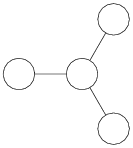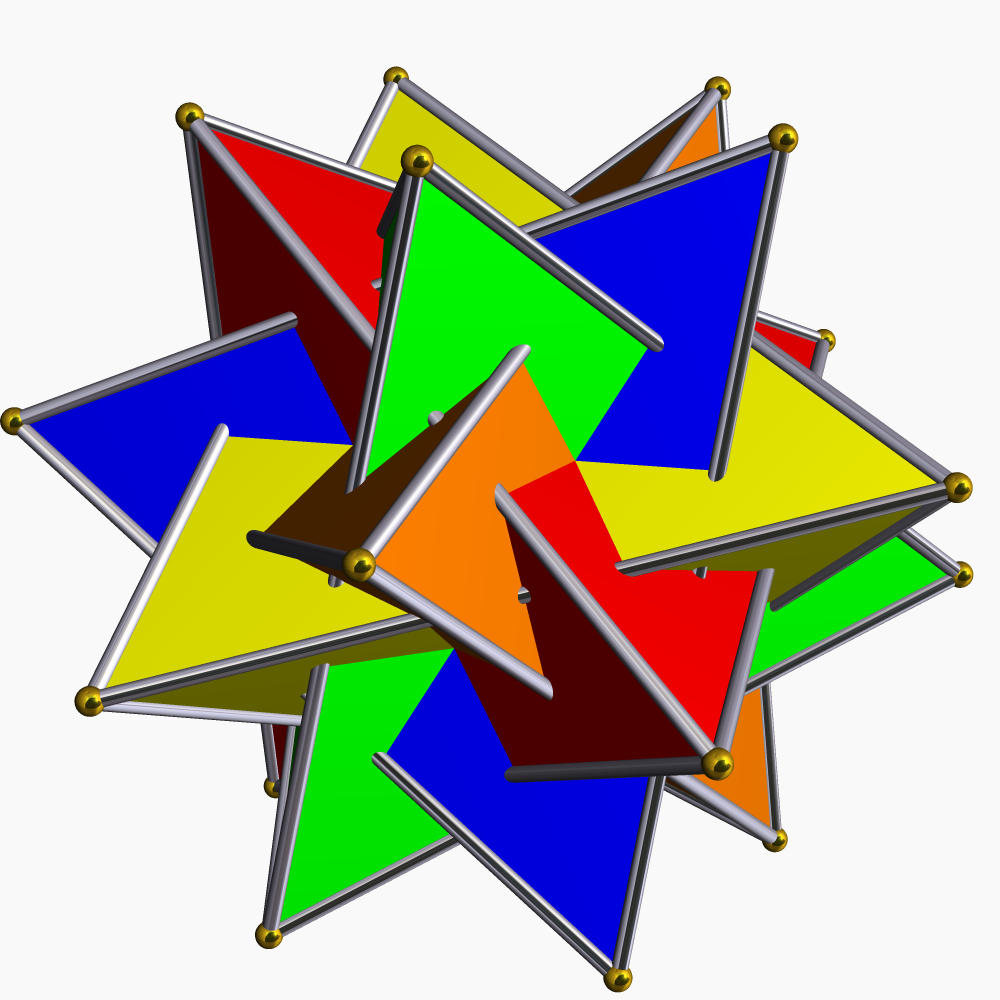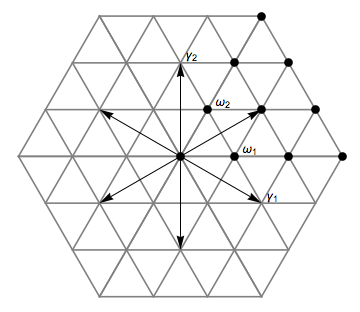|
Maximal Torus
In the mathematical theory of compact Lie groups a special role is played by torus subgroups, in particular by the maximal torus subgroups. A torus in a compact Lie group ''G'' is a compact, connected, abelian Lie subgroup of ''G'' (and therefore isomorphic to the standard torus T''n''). A maximal torus is one which is maximal among such subgroups. That is, ''T'' is a maximal torus if for any torus ''T''′ containing ''T'' we have ''T'' = ''T''′. Every torus is contained in a maximal torus simply by dimensional considerations. A noncompact Lie group need not have any nontrivial tori (e.g. R''n''). The dimension of a maximal torus in ''G'' is called the rank of ''G''. The rank is well-defined since all maximal tori turn out to be conjugate. For semisimple groups the rank is equal to the number of nodes in the associated Dynkin diagram. Examples The unitary group U(''n'') has as a maximal torus the subgroup of all diagonal matrices. That is, : T = \left\. ''T'' is c ... [...More Info...] [...Related Items...] OR: [Wikipedia] [Google] [Baidu] |
Mathematics
Mathematics is a field of study that discovers and organizes methods, Mathematical theory, theories and theorems that are developed and Mathematical proof, proved for the needs of empirical sciences and mathematics itself. There are many areas of mathematics, which include number theory (the study of numbers), algebra (the study of formulas and related structures), geometry (the study of shapes and spaces that contain them), Mathematical analysis, analysis (the study of continuous changes), and set theory (presently used as a foundation for all mathematics). Mathematics involves the description and manipulation of mathematical object, abstract objects that consist of either abstraction (mathematics), abstractions from nature orin modern mathematicspurely abstract entities that are stipulated to have certain properties, called axioms. Mathematics uses pure reason to proof (mathematics), prove properties of objects, a ''proof'' consisting of a succession of applications of in ... [...More Info...] [...Related Items...] OR: [Wikipedia] [Google] [Baidu] |
Rotation Group SO(3)
In mechanics and geometry, the 3D rotation group, often denoted SO(3), is the group of all rotations about the origin of three-dimensional Euclidean space \R^3 under the operation of composition. By definition, a rotation about the origin is a transformation that preserves the origin, Euclidean distance (so it is an isometry), and orientation (i.e., ''handedness'' of space). Composing two rotations results in another rotation, every rotation has a unique inverse rotation, and the identity map satisfies the definition of a rotation. Owing to the above properties (along composite rotations' associative property), the set of all rotations is a group under composition. Every non-trivial rotation is determined by its axis of rotation (a line through the origin) and its angle of rotation. Rotations are not commutative (for example, rotating ''R'' 90° in the x-y plane followed by ''S'' 90° in the y-z plane is not the same as ''S'' followed by ''R''), making the 3D rotation grou ... [...More Info...] [...Related Items...] OR: [Wikipedia] [Google] [Baidu] |
Outer Automorphism
In mathematics, the outer automorphism group of a group, , is the quotient, , where is the automorphism group of and ) is the subgroup consisting of inner automorphisms. The outer automorphism group is usually denoted . If is trivial and has a trivial center, then is said to be complete. An automorphism of a group that is not inner is called an outer automorphism. The cosets of with respect to outer automorphisms are then the elements of ; this is an instance of the fact that quotients of groups are not, in general, (isomorphic to) subgroups. If the inner automorphism group is trivial (when a group is abelian), the automorphism group and outer automorphism group are naturally identified; that is, the outer automorphism group does act on the group. For example, for the alternating group, , the outer automorphism group is usually the group of order 2, with exceptions noted below. Considering as a subgroup of the symmetric group, , conjugation by any odd permutation is an ... [...More Info...] [...Related Items...] OR: [Wikipedia] [Google] [Baidu] |
Orbit Space
In mathematics, a group action of a group G on a set S is a group homomorphism from G to some group (under function composition) of functions from S to itself. It is said that G acts on S. Many sets of transformations form a group under function composition; for example, the rotations around a point in the plane. It is often useful to consider the group as an abstract group, and to say that one has a group action of the abstract group that consists of performing the transformations of the group of transformations. The reason for distinguishing the group from the transformations is that, generally, a group of transformations of a structure acts also on various related structures; for example, the above rotation group also acts on triangles by transforming triangles into triangles. If a group acts on a structure, it will usually also act on objects built from that structure. For example, the group of Euclidean isometries acts on Euclidean space and also on the figures drawn ... [...More Info...] [...Related Items...] OR: [Wikipedia] [Google] [Baidu] |
Orbit (group Theory)
In mathematics, a group action of a group G on a set S is a group homomorphism from G to some group (under function composition) of functions from S to itself. It is said that G acts on S. Many sets of transformations form a group under function composition; for example, the rotations around a point in the plane. It is often useful to consider the group as an abstract group, and to say that one has a group action of the abstract group that consists of performing the transformations of the group of transformations. The reason for distinguishing the group from the transformations is that, generally, a group of transformations of a structure acts also on various related structures; for example, the above rotation group also acts on triangles by transforming triangles into triangles. If a group acts on a structure, it will usually also act on objects built from that structure. For example, the group of Euclidean isometries acts on Euclidean space and also on the figures draw ... [...More Info...] [...Related Items...] OR: [Wikipedia] [Google] [Baidu] |
Centralizer
In mathematics, especially group theory, the centralizer (also called commutant) of a subset ''S'' in a group ''G'' is the set \operatorname_G(S) of elements of ''G'' that commute with every element of ''S'', or equivalently, the set of elements g\in G such that conjugation by g leaves each element of ''S'' fixed. The normalizer of ''S'' in ''G'' is the set of elements \mathrm_G(S) of ''G'' that satisfy the weaker condition of leaving the set S \subseteq G fixed under conjugation. The centralizer and normalizer of ''S'' are subgroups of ''G''. Many techniques in group theory are based on studying the centralizers and normalizers of suitable subsets ''S''. Suitably formulated, the definitions also apply to semigroups. In ring theory, the centralizer of a subset of a ring is defined with respect to the multiplication of the ring (a semigroup operation). The centralizer of a subset of a ring ''R'' is a subring of ''R''. This article also deals with centralizers and nor ... [...More Info...] [...Related Items...] OR: [Wikipedia] [Google] [Baidu] |
Weyl Group
In mathematics, in particular the theory of Lie algebras, the Weyl group (named after Hermann Weyl) of a root system Φ is a subgroup of the isometry group of that root system. Specifically, it is the subgroup which is generated by reflections through the hyperplanes orthogonal to at least one of the roots, and as such is a finite reflection group. In fact it turns out that ''most'' finite reflection groups are Weyl groups. Abstractly, Weyl groups are finite Coxeter groups, and are important examples of these. The Weyl group of a semisimple Lie group, a semisimple Lie algebra, a semisimple linear algebraic group, etc. is the Weyl group of the root system of that group or algebra. Definition and examples Let \Phi be a root system in a Euclidean space V. For each root \alpha\in\Phi, let s_\alpha denote the reflection about the hyperplane perpendicular to \alpha, which is given explicitly as :s_\alpha(v)=v-2\frac\alpha, where (\cdot,\cdot) is the inner product on V. The Weyl ... [...More Info...] [...Related Items...] OR: [Wikipedia] [Google] [Baidu] |
Compact Group
In mathematics, a compact (topological) group is a topological group whose topology realizes it as a compact topological space (when an element of the group is operated on, the result is also within the group). Compact groups are a natural generalization of finite groups with the discrete topology and have properties that carry over in significant fashion. Compact groups have a well-understood theory, in relation to group actions and representation theory. In the following we will assume all groups are Hausdorff spaces. Compact Lie groups Lie groups form a class of topological groups, and the compact Lie groups have a particularly well-developed theory. Basic examples of compact Lie groups include * the circle group T and the torus groups T''n'', * the orthogonal group O(''n''), the special orthogonal group SO(''n'') and its covering spin group Spin(''n''), * the unitary group U(''n'') and the special unitary group SU(''n''), * the compact forms of the exceptional Lie ... [...More Info...] [...Related Items...] OR: [Wikipedia] [Google] [Baidu] |
Root System
In mathematics, a root system is a configuration of vector space, vectors in a Euclidean space satisfying certain geometrical properties. The concept is fundamental in the theory of Lie groups and Lie algebras, especially the classification and representation theory of semisimple Lie algebras. Since Lie groups (and some analogues such as algebraic groups) and Lie algebras have become important in many parts of mathematics during the twentieth century, the apparently special nature of root systems belies the number of areas in which they are applied. Further, the classification scheme for root systems, by Dynkin diagrams, occurs in parts of mathematics with no overt connection to Lie theory (such as singularity theory). Finally, root systems are important for their own sake, as in spectral graph theory. Definitions and examples As a first example, consider the six vectors in 2-dimensional Euclidean space, R2, as shown in the image at the right; call them roots. These vectors Li ... [...More Info...] [...Related Items...] OR: [Wikipedia] [Google] [Baidu] |
Exponential Map (Lie Theory)
In the theory of Lie groups, the exponential map is a map from the Lie algebra \mathfrak g of a Lie group G to the group, which allows one to recapture the local group structure from the Lie algebra. The existence of the exponential map is one of the primary reasons that Lie algebras are a useful tool for studying Lie groups. The ordinary exponential function of mathematical analysis is a special case of the exponential map when G is the multiplicative group of positive real numbers (whose Lie algebra is the additive group of all real numbers). The exponential map of a Lie group satisfies many properties analogous to those of the ordinary exponential function, however, it also differs in many important respects. Definitions Let G be a Lie group and \mathfrak g be its Lie algebra (thought of as the tangent space to the identity element of G). The exponential map is a map :\exp\colon \mathfrak g \to G which can be defined in several different ways. The typical modern definition ... [...More Info...] [...Related Items...] OR: [Wikipedia] [Google] [Baidu] |
Cartan Subalgebra
In mathematics, a Cartan subalgebra, often abbreviated as CSA, is a nilpotent subalgebra \mathfrak of a Lie algebra \mathfrak that is self-normalising (if ,Y\in \mathfrak for all X \in \mathfrak, then Y \in \mathfrak). They were introduced by Élie Cartan in his doctoral thesis. It controls the representation theory of a semi-simple Lie algebra \mathfrak over a field of characteristic 0 . In a finite-dimensional semisimple Lie algebra over an algebraically closed field of characteristic zero (e.g., a Cartan subalgebra is the same thing as a maximal abelian subalgebra consisting of elements ''x'' such that the adjoint endomorphism \operatorname(x) : \mathfrak \to \mathfrak is semisimple (i.e., diagonalizable). Sometimes this characterization is simply taken as the definition of a Cartan subalgebra.pg 231 In general, a subalgebra is called toral if it consists of semisimple elements. Over an algebraically closed field, a toral subalgebra is automatically abelian. Thus, ove ... [...More Info...] [...Related Items...] OR: [Wikipedia] [Google] [Baidu] |






